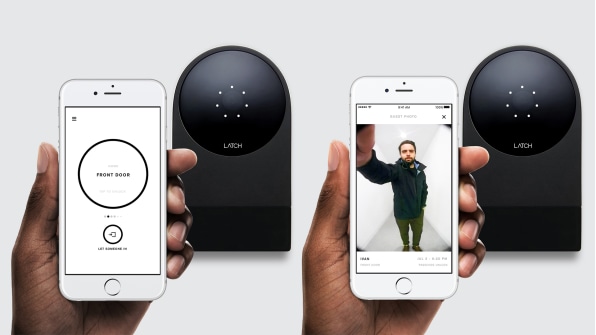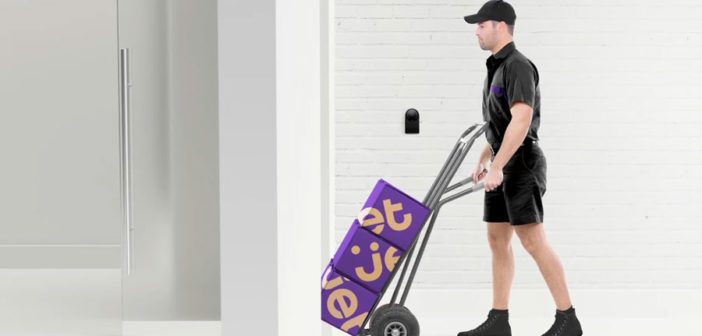Run by a former Apple public-policy wonk, Latch wants to be the infrastructure that enables the home delivery services of the future.
It’s a cliche that inventing good software is easy, while creating good hardware is almost impossible. The reason seems simple enough: Software can always be updated, but hardware can’t change once the factory lines start running.
But that simple fact belies a deeper truth. Look at any piece of hardware today—whether it’s a Fitbit or an iPhone—and you’re not just looking at a bet about what people want to buy today. You’re seeing a bet about what people want to buy today that was made at least three years ago. You’re seeing ideas delivered on a time-delayed fuse. Which means that any company hoping to succeed in hardware has to make a bet about the future.
Four years ago, Luke Schoenfelder was working as a junior policy wonk for Apple in D.C. when he made his bet (more on that in a bit). Today, his company, Latch, might be the least heralded competitor in the over-saturated smart-lock space. But after $37 million in venture capital and an unusually long time running in stealth mode, Latch seems primed. Today, the company unveiled news that it would be the lock maker of choice for Airbnb’s newest housing experiment, Niido. But even more, Schoenfelder thinks Latch is in position for the freaky future of bespoke home delivery services.
THE INFRASTRUCTURE PLAY
As Schoenfelder tells it, he’s been an infrastructure geek ever since he was a little kid in Pennsylvania. The farm where he grew up was first built in the 1700s; the property had buildings on it spanning every era of construction from wood to stone, then brick. “I started building houses on our property and other things, like a dam on our stream to get running water into one of the houses,” Schoenfelder recalls. What interested him was how, in any building, you could see technologies layered atop each other, evolving together. After a stint at Apple, working on corporate policy issues such as fake Apple stores in China and data privacy guidelines, Schoenfelder went to Haiti. Looking to graft better infrastructure onto the existing grid, he and a friend, Brian Jones, started a company that would allow Haitians to pay their energy bills via SMS, using a plug-in smart meter for houses. That startup failed, but it changed the way Schoenfelder saw things: not as product problems, but as systems problems.
Funding for that business fell through, but at a startup networking event in 2013, Schoenfelder happened upon a hacker type who’d wired up a small computer to the intercom system at his condo, so that he could remotely unlock his door. It hit him soon after that no one would ever want to do such a thing on their own—but that if buildings did it for all their tenants, then you could quickly imagine all kinds of services that might spring up.”Grocery delivery hit me immediately. The most extreme thing I could imagine was that someone would order groceries, and have them delivered to their actual fridge,” Schoenfelder recalls. “I figured that’s where things would have to be in three to seven years. I knew you could build a business if you simply had the product to enable that.”
Scheonfelder kept thinking, and realized something basic and tantalizing: There is almost no other product in your home that you touch as much as your keys. You might operate your thermostat twice a day; your refrigerator, five times. But most people reach for the keys at least 10 times a day. “That’s a rare level of utilization,” says Schoenfelder. “Anywhere you have high numbers of user touchpoints, you have something that can spill over into infrastructure. And looking at infrastructure, I couldn’t see anything as important as access.” Within a week of meeting that random hardware hacker, he had cashed out his 401K at Apple and spent the proceeds on filing a patent for a lock system that would allow for e-commerce orders to be delivered directly into a home—while also offering access credentials to any service, from dog walking to home sharing.
Schoenfelder now holds a patent that seems squarely placed exactly where Amazon and others appear to be heading. And he’s just inked the deal to provide locks for Niido, the apartment-building startup supported by Airbnb that would allow residents to share their apartments—but have that sharing arrangement managed by the apartment company, so that tenants can essentially generate cash with as little effort as possible. For Niido, having a smart-lock solution means the company can offer an apartment that effectively doubles as an income stream that can offset a high rent—thus enticing tenants with places they might otherwise not be able to afford. “We’re going into markets where people spend up to 50% on housing,” says Harvey Hernandez, Niido’s CEO. “If we can come in and provide technology that lets tenants monetize an empty apartment, we feel it’s not only socially responsible but a good business model.”

WHAT OTHER SERVICES COULD A SMART LOCK UNLOCK?
If you know only one smart lock, then it’s probably August, designed by Fuseproject, which was the first gadget offering the ability to get into your home using your cell phone—while also granting other people access, via app. Latch does much the same, but the similarities end in the markets they’re meant to serve. Where August is a consumer product meant to fit into the deadbolts you find on single-family houses, you can’t buy Latch yourself. It’s only sold to managers running apartments and condos, for the simple fact that those managers buy in bulk and also face more complex problems related to building access. The lock itself is also much beefier, owing to the extreme fire-proofing required to meet multi-family building codes. (Latch recently also released a lock fitting common deadbolts.)
Apartments and condos typically have many types of doors—the front door, the storage room, the residence, the exercise room—and managing them all consumes a surprisingly huge amount of time. Building managers have to constantly let people in that might range from visitors to contractors; they replace dozens of lost keys every month. Residents in turn must deal with a different key to get into every type of door on the property. “It’s a huge operational burden,” points out Scheonfelder. One of Latch’s existing customers has 1,200 locks across three different towers. Because those towers have a range of amenities, every single resident has access to a whopping 44 doors in the building.
The Latch lock, designed by Thomas Meyerhoffer—best known as the designer of the Sidekick and as an ex-understudy of Jony Ive’s at Apple—hides a range of capabilities. Users can use a key pad, phone, or key card to get in. The app lets residents and managers send out access codes to anyone they like, and those access codes expire after however long they designate. That’s the appeal for Niido, the Airbnb-connected apartment startup—building managers can centrally manage all the Airbnb guests, while creating an accurate log of all activity. Because Latch is really providing a service to building managers, selling locks is only part of their business model: They charge $5 each month for every tenant using the service. “Hardware makes money, but the goal is to have a long-term relationship and provide value for as long as possible,” Schoenfelder says, with a breezy fluency that must have been catnip to investors hunting for subscription revenues.
To be clear, Schoenfelder’s vision assumes the building managers do in fact see the value. His future plans hinge upon a massive uptake of Latch in buildings and offices everywhere. The idea is that Latch might eventually become an access platform connecting all the places you might need to get into—whether that’s your office, your home, or your gym. The goal is for Latch to become a platform for managing access with a user profile rather than a key. Asked what company he would like Latch to become, he doesn’t cite Apple or Facebook. He reaches for American Express, and the invention of traveller’s checks. “You used to have to carry cash because no one would take out-of-state bank checks,” he explains. “AMEX created this complete transparency in transaction. Latch has that same responsibility.”
Schoenfelder won’t say what he sees as being the next wave of services that will hinge upon getting strangers into your apartment building. But he concedes that there are entire categories of delivery service yet to be invented—and indeed, new services entirely. “There are amazing things you can do once you shift consumer behavior around shopping. You have an ecosystem of all these needs coming together in a single place.” He then drops a bit more of a hint. “You can imagine coming home to dinner already laid out on your table. That sounds extreme but we believe the world will be there 10 years from now. We want to serve the market and even accelerate it by handing people the tool and the infrastructure.”
–
This article first appeared in www.fastcodesign.com
Seeking to build and grow your brand using the force of consumer insight, strategic foresight, creative disruption and technology prowess? Talk to us at +9714 3867728 or mail: info@groupisd.com or visit www.groupisd.com



